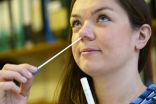(Press-News.org) Professor Dan Davis and his team at the Manchester Collaborative Centre for Inflammation Research, working in collaboration with global healthcare company GSK, investigated how different types of immune cells communicate with each other - and how they kill cancerous or infected cells. Their research has been published in Nature Communications.
Professor Davis says: "We studied the immune system and then stumbled across something that may explain why some drugs don't work as well as hoped. We found that immune cells secrete molecules to other cells across a very small gap. This happens when immune cells talk to each other and also, when they kill diseased cells. But crucially, some types of drugs aren't able to penetrate the gap between the cells. So they can't easily reach targets within the gap, to work effectively."
The researchers took molecules of different sizes and colours and used microscopic imaging to see which size of molecule could get into the gap between an immune cell and another cell. They found that only the smaller molecules could penetrate the gap.
They even found that when an immune cell attaches to another cell it clears out all but the smallest molecules between them.
Professor Davis explains the significance of their findings: "Our research demonstrates that any drugs targeting immune cells need to be very small. Antibody proteins, for example, are too big and aren't able to get into the gap between the cells - they're even cleared away when cells meet. To make them more effective they must be smaller - something that GSK is working on."
This research leads to new ideas for making drugs that, for example switch off immune activity in auto-immune diseases like diabetes or increasing immune reactivity to cancer. "A lot of important targets for future medicines are in the very small gap between cells. This research demonstrates why in certain cases we may need drug molecules to be smaller to work effectively," said Simon Chell, from GSK's Biopharm R&D team.
PhD student Adam Cartwright played a key role in the research, spending time at GSK as well as in Davis's lab at the University of Manchester.
He says: "Being able to test out our theory with medicines that GSK has designed was fantastic. The idea that something I had found out can be used to develop treatments to help patients is incredibly exciting."
Professor Davis, author of the popular Penguin paperback The Compatibility Gene, concludes: "The practical application of this basic research comes from bouncing around our ideas with scientists working on drug design. The interaction between academia and pharma is hugely beneficial and we hope it will lead to more effective drug treatments."
INFORMATION:
Notes for editors
Please note the embargo: 10.00am UK time, Wednesday 19 November 2014
The paper 'The immune synapse clears and excludes molecules above a size threshold' is due to be published in Nature Communications. DOI: NCOMMS6479
High resolution images on request.
The Manchester Collaborative Centre for Inflammation Research
The MCCIR was established in October 2012 to address current priorities in inflammatory disease in an open innovation, pre-competitive collaboration between academia and the pharmaceutical industry. GlaxoSmithKline, AstraZeneca and The University of Manchester have each invested £5M to promote "blue skies" research over the next 5 years. Our mission is to bring together clinical, industrial, and academic scientists - and innovate at this interface or in this unique interactive environment.
Register to receive news releases: https://www.manchester.ac.uk/discover/news/register-news-releases/
Follow The University of Manchester Media Relations Team on Twitter: https://twitter.com/UoMNews
For other social media: http://www.manchester.ac.uk/connect/social-media/
Media enquiries to:
Jamie Brown
Media Relations Officer
The University of Manchester
Tel: 0161 2758383
Mob: 07887 561318
Email: jamie.brown@manchester.ac.uk
A recent study by an Indiana University researcher has found that adolescents' alcohol use is influenced by their close friends' use, regardless of how much alcohol they think their general peers consume.
Jonathon Beckmeyer, assistant professor in the Department of Applied Health Science at the IU School of Public Health-Bloomington and author of the study, said his research generally focuses on the onset of teen alcohol use and how their social relationships shape those experiences.
"We've known for a long time that friends and peers have an influence on individual ...
SAN FRANCISCO, Nov. 19, 2014 -- Hox genes are master body-building genes that specify where an animal's head, tail and everything in between should go. There's even a special Hox gene program that directs the development of limbs and fins, including specific modifications such as the thumb in mice and humans. Now, San Francisco State University researchers show that this fin- and limb-building genetic program is also utilized during the development of other vertebrate features.
The discovery means this ancient genetic program is employed in a variety of features beyond ...
A new study, published online in Brain: A Journal of Neurology today, followed 43,368 individuals in Sweden for an average of 12.6 years to examine the impact of physical activity on Parkinson's disease risk. It was found that "a medium amount" of physical activity lowers the risk of Parkinson's disease.
Karin Wirdefeldt of the Karolinska Institutet in Stockholm and her colleagues used the Swedish National March Cohort to analyse comprehensive information on physical activity of all kinds. They assessed household and commuting activity, occupational activity, leisure ...
A new study led by researchers at King's College London in collaboration with the US Consortium of Food Allergy Research and the University of Dundee has found a strong link between environmental exposure to peanut protein during infancy (measured in household dust) and an allergic response to peanuts in children who have eczema early in life.
Around two per cent of school children in the UK and the US are allergic to peanuts. Severe eczema in early infancy has been linked to food allergies, particularly peanut allergy.
The study, published in the Journal of Allergy ...
New research on a number of Canadian lakes show that historical acid deposits as a result of industry have greatly reduced calcium levels in the water - dramatically impacting populations of calcium-rich plankton such as Daphnia water fleas that dominate these ecosystems.
Falling calcium levels mean Daphnia cannot get the nutrients they need to survive and reproduce, and are consequently consuming less food and becoming more susceptible to predators, leaving more algae for other organisms to feed on.
This has left a small jelly-clad organism called Holopedium to take ...
People with airway diseases, including asthma and chronic obstructive pulmonary disease (COPD), have a higher incidence of inflammatory bowel disease, such as Crohn's disease and ulcerative colitis, according to the findings of a new study.
The research, which is published online today (19 November 2014) in the European Respiratory Journal, is the first population-based study to examine the association between airway diseases and the incidence of bowel disease. The news comes on World COPD Day, which aims to improve awareness and care of COPD.
The results showed that ...
Researchers from the University of East Anglia (UEA) are a step closer to enhancing the generation of clean energy from bacteria.
A report published today shows how electrons hop across otherwise electrically insulating areas of bacterial proteins, and that the rate of electrical transfer is dependent on the orientation and proximity of electrically conductive 'stepping stones'.
It is hoped that this natural process can be used to improve 'bio batteries' which could produce energy for portable technology such as mobile phones, tablets and laptops - powered by human ...
People taking part in this year's Flusurvey, the UK's biggest crowd-sourced study of influenza will for the first time be offered a swab to confirm if their symptoms are caused by a flu virus or not as part of a new collaboration with i-sense. Data from social media and internet searches will also be combined with Flusurvey, allowing flu trends to be monitored across the UK more accurately and earlier than ever before.
Flusurvey scientists at the London School of Hygiene & Tropical Medicine will analyse weekly information relating to symptoms, provided in an online questionnaire ...
David King, clinical lecturer in paediatrics at the University of Sheffield, says medical professionals and consumers need to be aware that such devices "have no proved use in safeguarding infants or detecting health problems, and they certainly have no role in preventing [sudden infant death syndrome] SIDS."
Wearable devices for infants are a growing industry worldwide. Devices that attach to a newborn baby to monitor its vital signs are marketed by several US companies at a cost of around $200 to $300 to give parents "peace of mind" about their baby's health.
One ...
The authors say their findings are applicable to law enforcement work outside the US and support the view that stressful work related activities can "trigger" sudden cardiac death.
Law enforcement is a dangerous occupation. In 2011-2012, the fatality rate among US patrol officers was 15-16 per 100,000 full time workers - about 3-5 times the national average for private sector employees.
Some evidence suggests that cardiovascular disease is higher among police officers than the general population, but data about the impact of specific on duty activities ...



